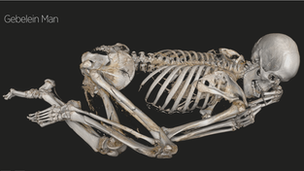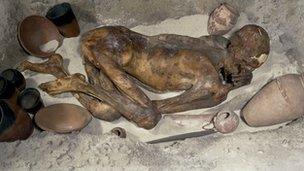British Museum exhibit Gebelein Man died 'violent death'
- Published

New technology can expose the man's skeleton indicating at closer glance where he was stabbed
A virtual post mortem has been undertaken on one of the British Museum's oldest mummies, Gebelein Man.
Using technology from Sweden, visitors to the museum will be able use an interactive touch screen to examine his body and internal organs.
The mummified man was buried in a crouching position around 3500 BC in Egypt and was discovered in 1896.
New evidence suggests he was stabbed in the back by a weapon, said curator of physical anthropology Daniel Antoine.
Dr Antoine said: "There's a wound on the surface of his skin, which people have been able to see for the last 100 years, but it's only through looking inside his body we've seen than his shoulder blade is damaged and the rib under the shoulder blade is also damaged.
"All of this suggests a violent death."
Thought to be between 18 and 21-years-old when he died, he was wrapped in linen and matting and placed in a shallow grave.
Direct contact with the hot, dry sand in which Gebelein Man was buried, naturally dried and mummified his remains.
He was found at Gebelein, about 25 miles (40km) south of Thebes, in Egypt in 1896 and was acquired by the British Museum in 1900.
The digital autopsy table has come courtesy of the Interactive Institute and Visualization Center C based in Norrkoping, Sweden and visitors will be able to view it until 16 December.
The technology has made it possible to expose his skeleton and make virtual slices in order to explore his internal organs and brain, which is still present.

The Gebelein Man pictured here has been exhibited at the British Museum in London since 1900
Spokesman David Hughes said: "This powerful visualisation system has enabled not just remarkable new revelations about one of the British Museum's most iconic mummies, but also brings the thrill of discovery straight to the gallery for the public.
"Using exactly the same technology that the scientists use, visitors to the museum can now explore for themselves and, who knows, perhaps even make their own new discovery with the exhibit."
The Department of Ancient Egypt and Sudan at the British Museum houses the largest collection of Egyptian objects outside Egypt.
The artefacts illustrate every aspect of the cultures of the Nile Valley, from the Neolithic period in 10,000 BC until the twelfth century AD.
- Published29 October 2012
- Published20 September 2012